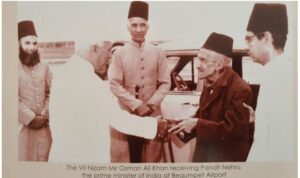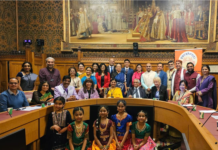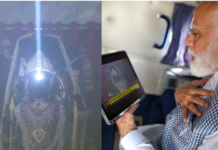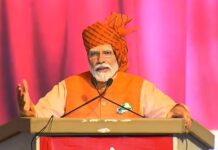It is a single historical event, but different political perspectives will see parallel events held to commemorate the occasion. The Union government will mark September 17 as ‘Hyderabad Liberation Day,’ while the Telangana government will mark it as ‘National Integration Day,’ as the BJP and Telangana Rashtra Samithi (TRS) compete for votes in the Telangana assembly elections next year.

On September 17, 1948, the Nizam of Hyderabad, Mir Osman Ali Khan, the seventh in the Asaf Jahi dynasty, surrendered in the aftermath of Operation Polo, an Indian military invasion of Hyderabad. It is widely assumed to be the day Hyderabad joined the Indian Union. In reality, this is not the case. On January 26, 1950, the Nizam was appointed as the ‘Rajpramukh’ of Hyderabad state.
HISTORY:
When India gained independence in 1947, Lord Mountbatten, the country’s last viceroy, was appointed to oversee the process and ensure a smooth transition of power. The British offered all 565 princely states the option of joining either India or Pakistan. Based on their geographical location, the majority of the 565 princely states decided to join either India or Pakistan and signed the Instrument of Accession. Some saw this as an opportunity to reclaim their former glory. The Nizam of Hyderabad was adamant about remaining an independent state with its own government.
While the other princely states were small and self-sufficient, it made sense for them to become a part of India (or Pakistan), Hyderabad was already prosperous and was recognised as the richest state. The state was truly self-sufficient, with its own currency (Hyderabadi Rupee), army, railway network, radio network, postal system, and so on. The Nizam Osman Ali Khan was the world’s richest man, regularly featured in international magazines such as TIME.
At the time, Hyderabad included parts of today’s Andhra Pradesh, Telangana, Karnataka, Maharashtra, Madhya Pradesh, and Chattisgarh. However, it was completely landlocked (It was surrounded by Indian land from all sides).
Patel, who was tasked with integrating Indian states and kingdoms, categorically stated that Hyderabad must be integrated into India. However, Nizam refused to sign the treaty of accession. Following Lord Mountbatten’s intervention, a standstill agreement was signed between India and Hyderabad, under which the state of affairs will be maintained for one year. According to the agreement, Hyderabad will continue to operate as usual. Unless there is an internal emergency, India cannot intervene in its affairs. But Patel was committed about making Hyderabad a part of India, and he kept pushing from the sidelines. Patel made it absolutely clear to Laik Ali (Nizam’s representative in Delhi) that Hyderabad, like all other kingdoms, must be a part of India. He stated unequivocally that India will never agree to an independent Hyderabad. When Laik tried to argue, Patel simply told him there was no point in continuing the conversation. Patel had realised that polite requests would be pointless in this situation.

Meanwhile, two other princely states (Junagarh and Bhopal) that had wanted to join Pakistan had succumbed to Sardar Patel’s diplomacy and agreed to join India. The majority of the people in Junagarh wanted to be a part of India, while the ruler wanted to join Pakistan. India dispatched an army to surround Junagarh. The ruler panicked and fled India in an instant.
Nizam of Hyderabad recognised that India could use a similar strategy with Hyderabad. However, Nizam’s advisors assured him that Indian forces were occupied in Kashmir and could not come down to Hyderabad for military action. As a result, he continued to play the hard ball. During a meeting with Patel, Nizam’s representative Kasim Razvi arrogantly threatened to wipe out 1.2 million Hindus in Hyderabad if the Government of India interfered with Hyderabad’s functioning. The threat was dangerously real because Razvi commanded an army of 2 lakh Razakars (guerrilla militants) who could cause harmful effects in Hyderabad with a single signal.
There appeared to be no other way out of this impasse than to use force. Patel was unwilling to allow an 82,000-square-kilometer area in the middle of India to remain a separate state. Allowing this would make India’s internal security a permanent threat. He referred to it as an ulcer in India’s stomach. However, Nehru and many other political leaders were opposed to using force to include Hyderabad. Nehru even wanted to take this to the United Nations to avoid a direct confrontation. Patel wanted to avoid taking direct military action because doing so would force Hyderabad to side with Pakistan or take the matter to the United Nations. He was adamant that Hyderabad would eventually be absorbed into India.
Reports of atrocities against civilians began to emerge from Hyderabad in September 1948. It was also discovered that Hyderabad made a Rs 20 crore loan to Pakistan (in violation of the “Standstill Agreement”). Because Pakistan was already inciting unrest in Kashmir, it was obvious that the funds sent by Nizam would be used to fund the war against India in Kashmir.
India didn’t need another reason to take action. Patel, who was ill at the time, immediately wrote to Nehru, requesting that the army be sent to Hyderabad. It was necessary to act quickly so that Nizam did not have time to involve the UN or Pakistan. And India did just that. Indian troops began marching into Hyderabad in the early hours of September 13, 1948, under the codename “Operation Polo.” The main force advanced along the Sholapur-Hyderabad road, with a smaller diversion along the Bezwada-Hyderabad road. Hyderabad had not expected this and was clearly unprepared for a war with India.

Mir Osman Ali Khan, the last Nizam of Hyderabad, receiving India’s first PM Jawaharlal Nehru at the Begumpet airport. (Photo: Siasat archives)
The Indian Army was generations ahead of the Hyderabad Army and the Razakars, with “state-of-the-art” military equipment from the 1940s. “It was all over” in 100 hours. On September 17, 1948, the Nizam went on the air and declared a cease-fire. On the 18th of September 1948, at 4 p.m., the Hyderabad Army, led by Major General El-Edroos, surrendered to General Chaudhari, who led the Indian Army. This was followed by a high-level meeting between Sardar Patel and Nizam Osman Ali Khan, during which the Nizam assured Sardar Patel that, despite everything that had happened in the past, he would now be loyal to the Indian Union and work in close collaboration with the Government of India for the benefit of the people.
And so, in just four days, Sardar Patel forced Hyderabad to become a part of India while completely avoiding the issue being brought before the UN. Hyderabad could have gone the way of Kashmir if he had not acted quickly.
WHY IS TRS OBSERVING SEPTEMBER 17 AS HYDERABAD INTEGRATION DAY:
The TRS despises the term “Hyderabad Liberation Day,” referring to it as “saffron jargon.” Furthermore, Owaisi, the MP from Hyderabad, had requested that the day be designated as National Integration Day to commemorate “the struggle of people against British colonialism and the feudal rule of the Nizam.”
While the TRS government hosts a public meeting in the Public Gardens on September 17, where the chief minister will unfurl the national flag, the AIMIM will hold a Tiranga motorcycle rally on September 16. On September 16, the TRS will also hold mass rallies in all assembly constituencies. On September 18, all district headquarters will host cultural events. The BJP says terming September 17 as National Integration Day is appeasement of the AIMIM.
WHY IS BJP OBSERVING SEPTEMBER 17 AS HYDERABAD LIBERATION DAY:
According to the party, the day commemorates the merger of the former state of Hyderabad with the Indian Union. On that day, Union Home Minister Amit Shah will deliver a special address at Secunderabad’s Army Parade Ground. Invites have been sent to the chief ministers of Karnataka and Maharashtra (whose states include portions ceded from the state of Hyderabad). According to the BJP, Maharashtra and Karnataka have designated September 17 as Marathwada Liberation Day and Hyderabad-Karnataka Liberation Day, respectively.
The Union government has also invited Telangana Chief Minister K. Chandrashekar Rao (KCR) to the programme, which will kick off a long series of events commemorating the 75th anniversary of the merger on September 17, 2023. Furthermore, the BJP claims that Telangana has not officially observed the occasion since the state’s formation because KCR was afraid of the Asaduddin Owaisi-led All India Majlis-e-Ittehadul Muslimeen (AIMIM). The’reason’: the AIMIM’s founders were allegedly linked to the Razakar militia during the Nizam’s reign.
At a party rally in Munugode on August 21, this year, Shah declared that September 17 would be officially celebrated once the BJP takes power in Telangana. The ultimate goal, according to Union Culture Minister G. Kishan Reddy, Lok Sabha MP from Secunderabad, is to make the younger generation in the region and elsewhere aware of the story of resistance, valour, and sacrifice that led to Hyderabad joining the Indian Union.
The Rashtriya Swayamsevak Sangh (RSS) has formed a committee, with Patna High Court retired judge L. Narasimha Reddy as honorary president, to commemorate Nizam Vimukta Swatantra Amrutotsav year-long celebrations.
 By: Anil Kumar
By: Anil Kumar

Readers like you, make ESHADOOT work possible. We need your support to deliver quality and positive news about India and Indian diaspora - and to keep it open for everyone. Your support is essential to continue our efforts. Every contribution, however big or small, is so valuable for our future.












quote a detailed and long account picking up thr mess left by firmer rulers
Sardar Patel’s tact, fearless nature and dedication to independent India once again proved winner Now each political party branding the liberation to the their own ends